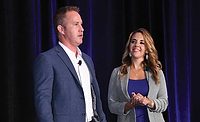PetersenDean Hit the Reset Button with Supply-Chain Financing

Since implementing a supply-chain finance program, the executive leadership team at PetersenDean hasn’t looked back. Officials said the company beat its own projections of 12 to 14 months to get back to normal by 10 to 12 months. Since then, the cash balance has almost tripled and the company’s reduced its credit line. “Furthermore, and most importantly, PrimeRevenue has helped us provide predictability and improve cash flow for our suppliers – which has meant better service and put us in a better position to find further savings,” said CFO Steve Doll.

Since implementing a supply-chain finance program, the executive leadership team at PetersenDean hasn’t looked back. Officials said the company beat its own projections of 12 to 14 months to get back to normal by 10 to 12 months. Since then, the cash balance has almost tripled and the company’s reduced its credit line. “Furthermore, and most importantly, PrimeRevenue has helped us provide predictability and improve cash flow for our suppliers – which has meant better service and put us in a better position to find further savings,” said CFO Steve Doll.


For those of us in the roofing business, it’s hard to escape the fact that residential construction is a flawed business model. A home can take six to nine months (or more) to construct — and that’s before it’s even sold to a customer. During that time, there can be anywhere from 25 to 35 different trades that are sequenced together to build a home — starting with the subdivision of land and creation of the infrastructure to serve that home all the way through the finishing work of installing appliances. Each of these milestones requires specialized tradecraft, which need to pay for labor and materials long before the home is brought to market.
To add to the challenge, traditional lenders have drastically reduced their exposure to the industry since the 2008 financial and mortgage crisis. Today’s construction firms are limited to asset-backed lending and financing that covers only a portion of their accounts receivable. Many of them are extending supplier payment terms as a way to cover this gap in financing — forced to finance their growth on the backs of their vendors.
In short, concerns about cash flow often take precedence over maximizing profitability. Rather than compound these problems, we at PetersenDean hoped to rethink the framework. Knowing the high value of liquidity, we sought a solution that would inject cash into our business. Our hope was without the constant immediacy of cash flow concerns, we could significantly improve the service we offered our customers and recapture a portion of that profitability from our supply chain.
We understand these cash flow challenges all too well. Rather than use dollar values, we often think about our business in terms of days. Our revenue cycle — or the number of days from when we receive materials into our inventory to the time we collect the cash from installing those materials — exceeded our payables cycle by about 20 days. We fund this shortfall with our cash balance and a senior credit facility. But our bank availability is precious to us. While it makes sense to finance the core business with this facility, it didn’t make sense to tie up availability simply for an early pay discount. For us to recapture some of the profitability from our suppliers, we needed a more flexible solution.
Then the Rain Started
Our challenge became a priority because of weather. For PetersenDean, 2017 was the ‘year it rained a lot.’ For those outside of California, here’s some context: the last time it rained as much as it did in the winter of 2017 was 1895. The impact on our business was immediate. Not only would we not send our people onto a roof in the rain, but because many of our projects require tearing off a roof and then installing new roofing and a solar system (a process that can take two or three days), we couldn’t start any jobs on a sunny day if rain was expected the next.
And, if we don’t put roofs on homes, we don’t collect money.
This gets mitigated a little by an almost entirely variable direct-cost structure. But our corporate and SG&A (selling, general and administrative) costs are much less variable. So, in addition to needing to pay the older invoices of our suppliers, we had to deal the normal fixed cost burden.
So our payable days began to grow.
From our suppliers’ standpoint, rain poses another problem as it affects every one of their installers in the region. So, just as we had to extend our payment terms in response to the rains, their other customers were in the same boat. Like us, they necessarily stretched their payments, compounding our supplier’s liquidity and effectively weakening our supply chain. While we have great relationships with our suppliers, we can’t ask them to risk financial distress for the sake of our relationship.
Initially, we financed this shortfall through a bank loan to avoid disruption of operations. However, we realized this approach was only a temporary stopgap measure to a larger problem — one that would soon become a much larger obstacle. It kept raining.
However, our homebuilder clients still had delivery schedules and our backlog just kept increasing. As a result, we knew once the rains ended, this problem would get worse before it got better.
As we started to see sunlight, we knew we’d need our supplier to substantially increase their shipments to PetersenDean so we could start to reduce the backlog. Our suppliers would need to do this before we could demonstrate that we were financially healthy, while our older balances continued to age.
Now, our cash flow challenge wasn’t just about recapturing our early pay discounts — it was about having the supplies we needed to address the spike in operating tempo without the onerous vendor restrictions that our partners would have likely required to mitigate their risk. In other words, our effort to pay vendor balances back down to normal levels was hampered by the fact these vendors would cost more.
Our best estimate was 12 to 14 months before things would return to “normal.” A one-time cash injection would not only give us a “financial reset,” it would also pay for itself because we’d be able to buy our materials at a discounted price. This would effectively allow us to obtain the discounts over a much broader base of business.
PetersenDean has survived four major economic slowdowns and recessions, but 2017 was the icing on the cake. It was time to take back control of our cash flow and to do it in a way that was respectful, and possibly even helpful, to our suppliers — many of which were experiencing cash flow challenges of their own.
The Game Changer
One option was to look for additional term debt, but the cost was high and marketing such a facility would take time that our management team didn’t have. However, it was during these exploratory conversations that we were first introduced to a new financing option: supply chain finance.
Supply-chain finance uses a two-step approach to accelerate cash flow. The first step is extending payment terms with suppliers. The second mitigates the negative impact on suppliers by allowing them to receive near-immediate payment for those invoices. By “selling” their invoices to a funder at a nominal fee (far less than the financing rate they would receive on their own), our suppliers could be paid in a matter of days (sometimes hours). In effect, by accelerating our own cash flow, we would help our suppliers do the same.
In other words, we didn’t need to use our vendors to finance our recovery. Because the rains had also impacted our vendors, they were often in no better shape to finance us than we were. At the very least, the financing would have been more expensive. Instead, a supply chain partner with the financial resources to better provide capital would step in. Not only would they cover the value of the goods we purchased, but they would give us additional days to repay. These additional days were the catalyst that allowed us to recover even quicker.
Finding the right supply chain finance partner was a task we took very seriously — after all, they would be interacting with our most valuable suppliers. It’s IT-enabled, so we wanted to make sure it was easy to use without making any changes to our existing accounts-payables process. We also wanted a partner that understood our business and how to work with our suppliers.
We also wanted to work with a supply-chain finance partner that had multiple sources of funding available to us. I’ve been around the block long enough to know that, depending on the economic climate, banks can close or decide to exit a program. There was no way we were going to get a supply-chain finance program up and running if its success hinged on a single source of funding. The partner that met our requirements was PrimeRevenue.
Since implementing our supply-chain finance program, we haven’t looked back. We beat our projection of 12 to 14 months to get back to normal by 10 to 12 months. Since then, our cash balance has almost tripled and we’ve reduced our credit line. Furthermore, and most importantly, PrimeRevenue has helped us provide predictability and improve cash flow for our suppliers — which has meant better service and put us in a better position to find further savings.
Today, our biggest cash flow challenge isn’t having access to enough working capital, it’s figuring where to reinvest the extra liquidity on hand. In fact, we’re looking at making arrangements with some of our key suppliers to effectively reduce our days payable to an almost nominal amount (as little as one week). The certainty of this financing effectively allows them to redirect their working capital elsewhere and substantially increases our savings.
Plus, I have to admit, having the liquidity to make choices is a lot more fun than having a lack of liquidity that forces those choices for us.
Looking for a reprint of this article?
From high-res PDFs to custom plaques, order your copy today!







